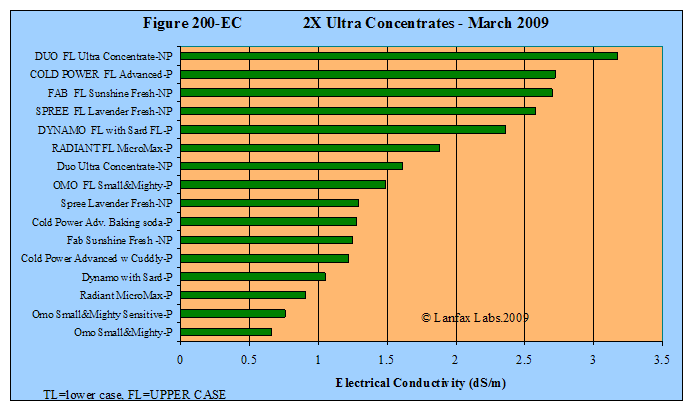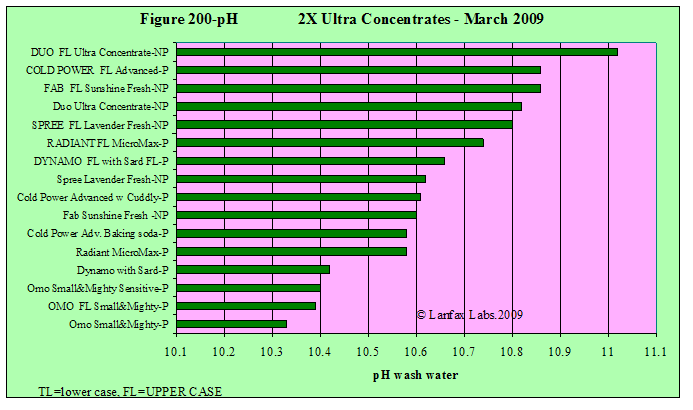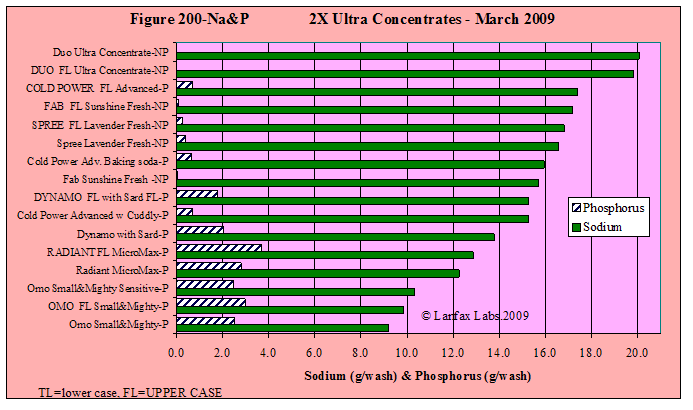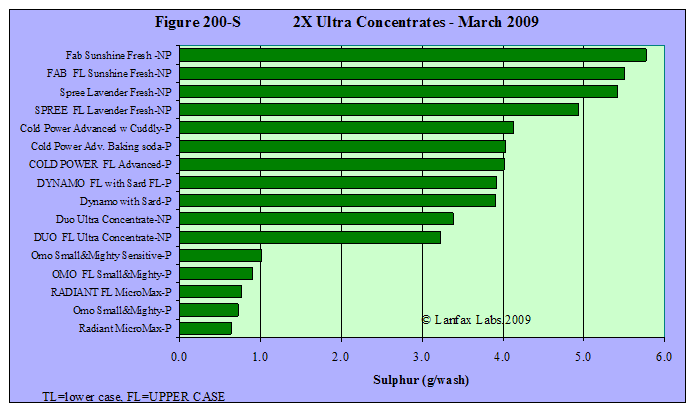2X-Ultra Concentrate Laundry
Powders
WASH ONLY
New to the market is a range of products labelled as 2X concentrates and 2X Ultra concentrates. These are not the first of the highly concentrated products as we tested four in our recent 2009 analysis of 71 samples. What is new is that the major manufacturers (Colgate-Palmolive Pty Ltd, Unilever Australasia, United Laboratories Pty Ltd and PZ-Cussons) seem to have taken a major step to reduce the volume of detergent required for a "normal" wash (whatever "normal" is supposed to mean). If the dose of these 2Xultra products is to be taken as the norm for ultra-concentrates, then other manufacturers were doing this for several years. For the last batch (2009), 22 of 42 front loader samples had doses less than 65 g, and 13 of 47 top loaders fell into this category.
We purchased 16 products from Coles Supermarket in Armidale NSW on 16th March 2009 and analysed these products (7 front loader and 9 top loader) during the same week. The results are shown below, all on this one page without any reference to the interpretation of the constituents. We will not be repeating information that is available on other pages of this website. So to see the implication of sodium on greywater, you need to read the pages on Sodium, Greywater and Gardens.
What we bought.
Packet
sizes varied from 0.5 kg, 0.65 kg to 1 kg.
Each pack came with a scoop that varied from 58 mL to 72 mL. These scoops are smaller than the scoops in the normal concentrates for these products.
When converted from volume to mass (required to calculate the number of washes per kilogram), the scoops varied from the smallest at 42 g to the largest at 65 g.
Moisture of each sample from a freshly opened pack of detergent varied from 1.05% to 13.7%.
Detergent doses
The doses for the front loader varied from 44.7 g
to 65.4 g, that equates to 23 to 15 washes per packet. From that
information, it is not possible to compare products for price unless you already
know that information. No pack displayed the number of washes per pack, and
there was insufficient information for you to make a calculation as to how many
washes per pack. As usual, you are being kept in the dark!
Analysis
Samples of freshly opened powders were measured using the scoop provided. In
each case, one scoop was required for a normal wash. The powder was mixed at the
ratio of one scoop in 25 L for front loaders and one scoop in
60 L for top
loaders. Samples were shaken for 30 minutes at 20oC, and pH, EC,
total alkalinity and turbidity measured within 30 minutes. Samples for
other elements were measured using ICP. Minor difference arise because the
powders are not always uniformly fine, some have small rounded beads while
others are coarse powders.
Phosphorus labelling
Only 6 of the 16 packets were labelled 'NP',(Spree, Fab and Duo), the others
were labelled 'P' with the dose of phosphorus stated as 0.6, 1.8, 2.5 or 4.2 g
per wash. The graph below shows the measured rates for phosphorus in each
detergent.
Salinity - as measured by
electrical conductivity (wash water only)
These values apply to the wash water only. If you
collect the wash and the rinse water combined, the EC value will be lower than
Figure 200-pH. The EC of the combined wash and rinse water will depend upon the
EC of the input water.
EC below1 dS/m preferred

pH (measure of the
acidity or alkalinity of the wash water - pH 7 is neutral, <7 is acid, >7
is alkali)
These values apply to the wash water only. If you
collect the wash and the rinse water combined, the pH value will be lower than
Figure 200-pH.

Sodium and Phosphorus in grams
per wash. Graph ranked on sodium, lowest at the bottom
Most of the sodium and phosphorus are in the wash water
with only the residue rinsed out. These values are in grams per wash,
irrespective of whether you use the wash water or the combined wash and rinse
water. If you use only the rinse water on your garden/lawn, these graphs
do not apply.

Sulphur (grams per wash)
